Camels on Lanzarote

|
Camels on Lanzarote
For many tourists a visit to
Lanzarote just isn’t complete without a camel ride around the islands main
attraction, the Volcano Park. Next on our list and we knew it was a very
different seating arrangement to that in Morocco. We began driving through the
National Park - Parque Nacional de Timanfaya and soon saw them lying in wait for
us.
The English
Chair
Riders at Timanfaya are invited to sit in an English Chair in order to increase their on-board comfort. This simple wooden device sits astride the camel and allows two people to hitch a ride at once. The camel drivers weight the chair in order to ensure an equal distribution of load. A big chap with a skinny partner would have ballast sacks put on the partners side. This contraption was named after the few slightly effete Victorian tourists, such as novelist Olivia Stone, who visited Lanzarote in the late 19th century. The scratchy experience of bare back riding favoured by the locals was just too much for them.  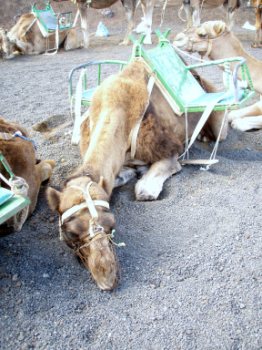 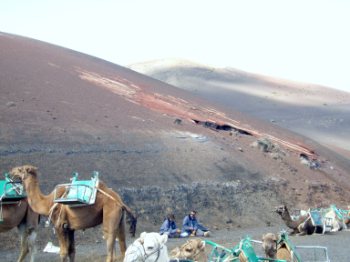 Bear went off to
the waiting gang. Ours was catching zeds - but
he was the strong silent type. The two herders
sitting enjoying their fag break didn't notice a group of camels setting off for
home. I remembered from our previous experience with their Moroccan cousins and
said,
"They will be off to where they were
born then"
They'll have
a bit of a swim.
Do you know what a powerful back
swing is - Bear does.
Poor Bear. See the bruise appear. Poor Bear.
"You nugget these were born here, you
can tell that by their missing nose flaps, they don't have to put up with the
Sahara here you know"
Rub Bear Rub.
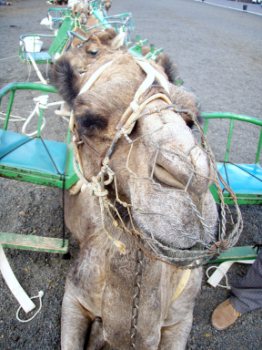 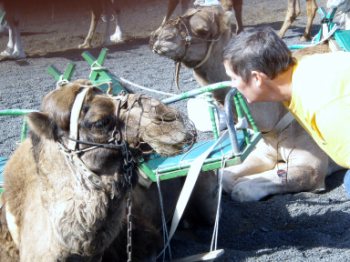
 Ours ready
for the off, a few encouraging words from me, the
column raring to go ballast sacks to their right.
Camels move differently to most mammals.
Right legs together, left legs together – creating the rolling motion that has
earned them the title of Ships of the Desert, coupled with their lack of need
for water as mentioned on their previous blog by the same title.
Camels in Combat  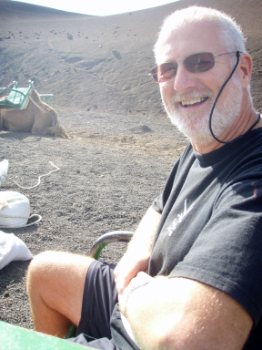 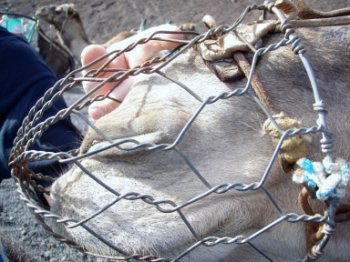 The column next
to ours were less inclined to rouse themselves. Bear
in position. Evidence of 'the non-nose flap',
they close theirs by muscles not doors, not so keen on the garden fence
muzzle.
Camel Rustling
Other authorities believe that camels were introduced in the late 15th century, by one of the first Spanish Governors of the Canary Islands, Diego Garcia Herrera. Still thirsting for further conquests after subduing the Canaries, Herrera started to conduct raids along the nearby African coastline. He was primarily on the hunt for people as Herrera deemed The Canary Islands to be too sparsely populated. Historians postulate though that he also returned with camels. According to Antonio Rumeau de Armas, author of The Canaries and the Atlantic: “That was the beginning of this long series of unexpected ambushes and attacks that during three centuries alternatively drenched the coast of Berberia and the defenceless islands of Lanzarote and Fuerteventura with blood, open grounds for the heroic deeds of the Herreras and Saavedras, that there encountered slaves with whom they increased their small population and rich booty consisting of grains, camels, sheep and horses …”. 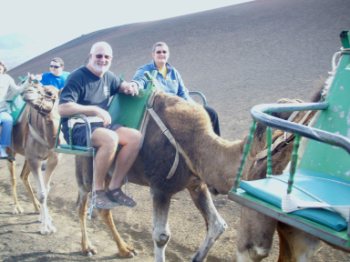   Ours was 'a
strong-un'. He didn't bump and grind about our joint weight, no
complaints at all in fact. Bear enjoying the view.
Sitting side by side in seats meant no sore thighs
the next day.
Camels and
Canaries
Camels were then introduced to the rest of the Canary Islands and even taken to the New World, where they didn’t adapt well, again as mentioned before, a feral population has recently been introduced to Australia. Lanzarote´s camel population grew rapidly from the 16th century onwards, as these animals were obviously well suited to the dry and arid conditions so prevalent on the island. The camels also adapted well to the major volcanic eruptions of the 1730´s which left around one third of the island buried beneath a sea of lava. The eruptions obviously forced local farmers to explore new methods of cultivation. The ingenious islanders soon discovered that they could use granules of volcanic rock, or picon, as a type of porous mulch. The picon absorbs moisture from the air, releases it into the ground and prevents evaporation. This enables a method of dry cultivation known as “enarenado” which is completely unique to Lanzarote. The only drawback to this new method of cultivation was that most work had to be done by hand and little in way of machinery could be used for fear of crushing the volcanic stone altogether, so preventing water dispersing into the soil. Enter the islands camels, which had already been used in the fields and as beasts of burden for a couple of hundred years. Now they led the ploughs through fields of picon. 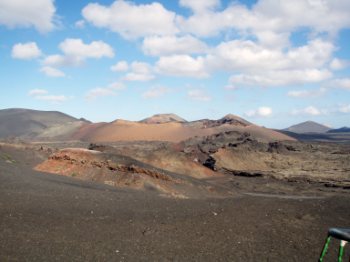   We strolled at a nice pace up the
sandy path to see amazing colours.
Plague of Pirates
Lanzarote’s camels were also engaged in less peaceful, non-pastoral activities. During the 17th and 18th centuries pirate raids continually plagued the island. English privateers were particularly persistent, often sacking the ships sitting in the natural harbour at Arrecife. The Camel Light
Brigade 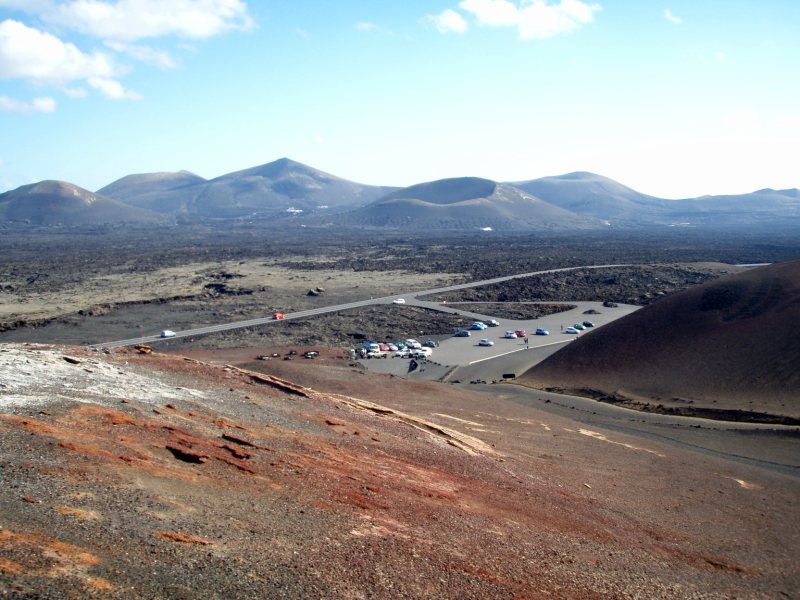 All in all worth the joint
ticket of 12 Euros, sitting next to each other. ARRRR ..................Rub Bear
Rub.
|